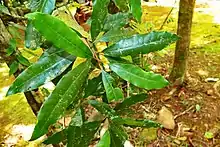Pycnandra acuminata
Pycnandra acuminata is a species of plant in the family Sapotaceae. It is a rainforest shrub, endemic to New Caledonia, and is adapted to the nickel-rich ultramafic soils found there. Pycnandra acuminata is notable as one of the most prolific hyperaccumulators of trace metals known, actively absorbing nickel from the soil and concentrating it within the plant to a concentration of up to 25% nickel citrate as dry weight of the sap, which is blue in colour due to the nickel content.[3] The vernacular name in French is sève bleue (blue sap).[4]
| Pycnandra acuminata | |
|---|---|
 | |
| Scientific classification | |
| Kingdom: | Plantae |
| Clade: | Tracheophytes |
| Clade: | Angiosperms |
| Clade: | Eudicots |
| Clade: | Asterids |
| Order: | Ericales |
| Family: | Sapotaceae |
| Genus: | Pycnandra |
| Species: | P. acuminata |
| Binomial name | |
| Pycnandra acuminata | |
| Synonyms[2] | |
| |
The reason for this adaptation is not well established, but heavy metals such as nickel in soil are usually toxic to plants and it is thought that by complexing them into less-toxic organic salts and concentrating them in certain tissues, the plant may protect other more sensitive tissue from excess levels of toxic metal ions, or deter herbivores due to the toxicity. Such plants are of considerable interest due to their potential use in phytoremediation of heavy metal contaminated former mine sites, or potentially even as a means of non-destructive phytomining of metal-rich soils allowing metals to be harvested in an environmentally sustainable manner.[5][6][7]
The tree's unusual affinity for nickel first came to light in the 1970s, and research into other hyperaccumulator plants has increased since then.[8]
References
- "Pycnandra acuminata (Pierre ex Baill.) Swenson & Munzinger". Plants of the World Online. The Trustees of the Royal Botanic Gardens, Kew. n.d. Retrieved July 12, 2020.
- "Pycnandra acuminata (Pierre ex Baill.) Swenson & Munzinger, Adansonia, sér. 3, 32: 243 (2010): Synonyms". World Checklist of Selected Plant Families. Royal Botanic Gardens, Kew. Retrieved 21 May 2019.
- Plants of New Caledonia. Atlanta Botanical Garden
- Site Endemia de Nouvelle Calédonie Pycnandra acuminata
- Rascio N, Navari-Izzo F. Heavy metal hyperaccumulating plants: how and why do they do it? And what makes them so interesting? Plant Sci. 2011 Feb;180(2):169-81. doi: 10.1016/j.plantsci.2010.08.016. PMID 21421358
- Callahan DL, Roessner U, Dumontet V, De Livera AM, Doronila A, Baker AJ, Kolev SD. Elemental and metabolite profiling of nickel hyperaccumulators from New Caledonia. Phytochemistry. 2012 Sep;81:80-9. doi: 10.1016/j.phytochem.2012.06.010. PMID 22795763
- Jaffré T, Pillon Y, Thomine S, Merlot S. The metal hyperaccumulators from New Caledonia can broaden our understanding of nickel accumulation in plants. Front Plant Sci. 2013 Jul 26;4:279. doi: 10.3389/fpls.2013.00279. PMID 23898341
- Halton, Mary (2018-09-05). "The tree that bleeds... metal?". BBC News. Retrieved 2018-09-05.